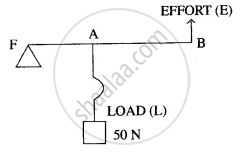Advertisements
Advertisements
प्रश्न
Shears, used for cutting metals and scissors used for cutting clothes are both examples of levers of the first order. However, whereas the shears always have short blades and long handles, the scissors often have blades much longer than the handles. Explain, why this is so?
उत्तर
The mechanical advantage of an (ideal) liver equals the ratio between-the effort arm to the load arm.
For the shears (used for cutting metals), the ‘load’ is really a formidable one. Therefore, we need a large mechanical advantage to keep the applied effort within reasonable limits. To ensure this, the shears are made to have short blades (small load arm) and long handles (long effort arm).
For the scissors (used for cutting clothes), the ‘load’ is an almost negligible one. Mechanical advantage, therefore, there may be more or less than one. The scissors, therefore, often have blades much longer than the handles.
APPEARS IN
संबंधित प्रश्न
Which class of lever will always have MA > 1 and why?
Name a machine to obtain gain in speed ?
State the principle of a lever?
Give one example of a class I lever where mechanical advantage is more than one ?
The following belong to which class of lever?
An oar of a boat
The following belong to which class of lever?
Human-arm
The following belong to which class of lever?
Fore-arm
The following are an example of levers. State the class of lever to which each one belongs giving the relative positions of Load (L), Effort (E), Fulcrum (F):
(i) Scissors (ii) Sugar tongs (iii) Nutcracker (iv) Pliers.
The diagram below shows a lever in use.

(i) To which class of lever does it belong?
(ii) If FA = 40 cm, AB = 60 cm, then find the mechanical advantage of the lever.
What is a first-order lever?
